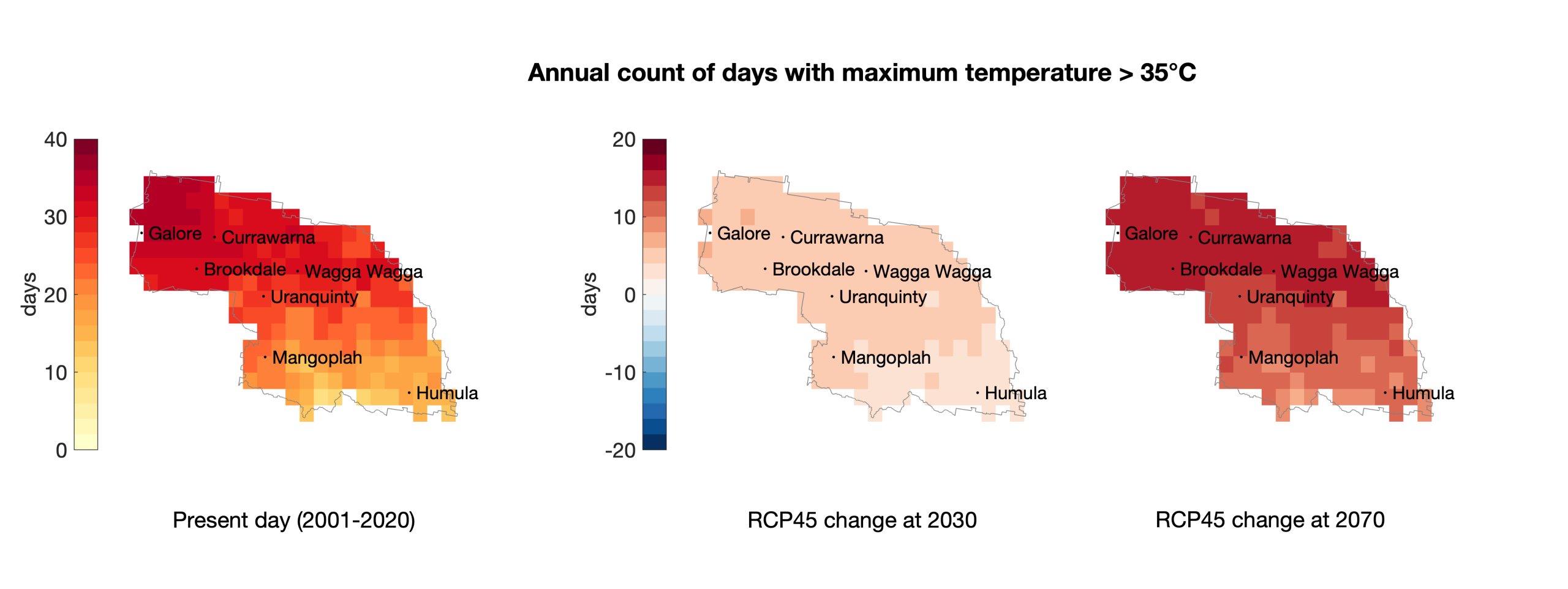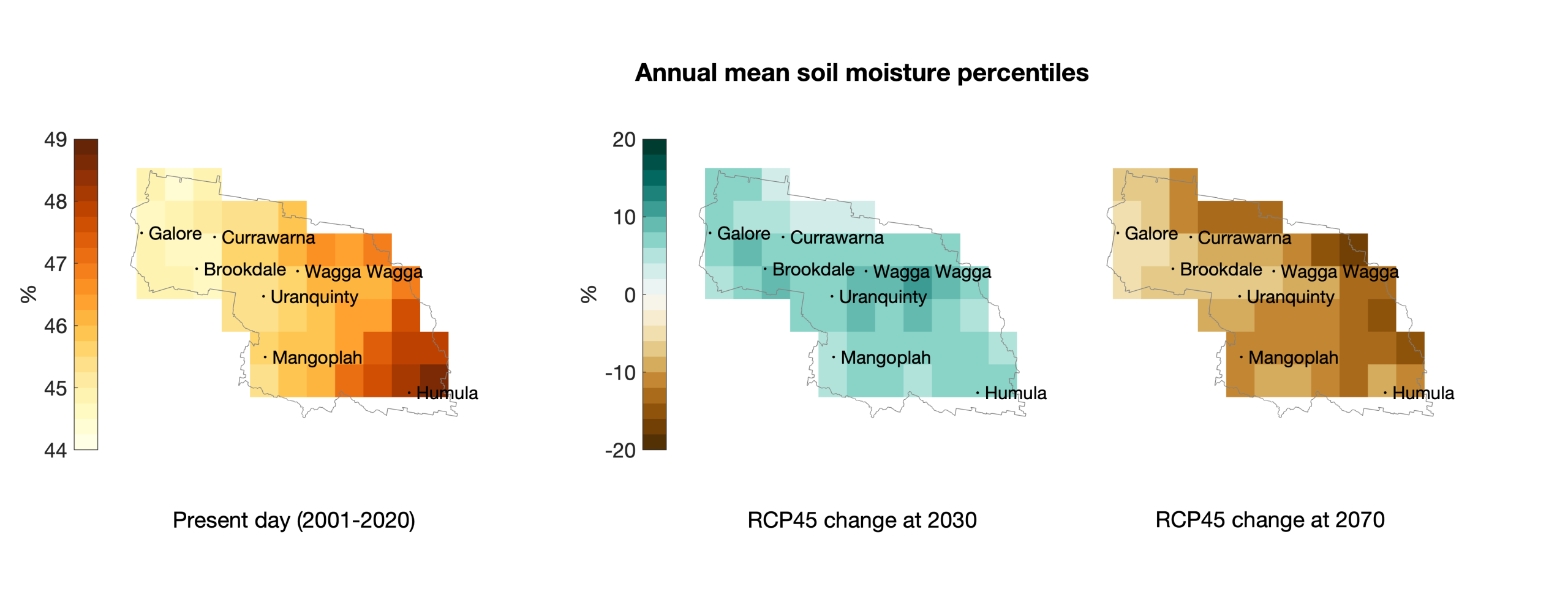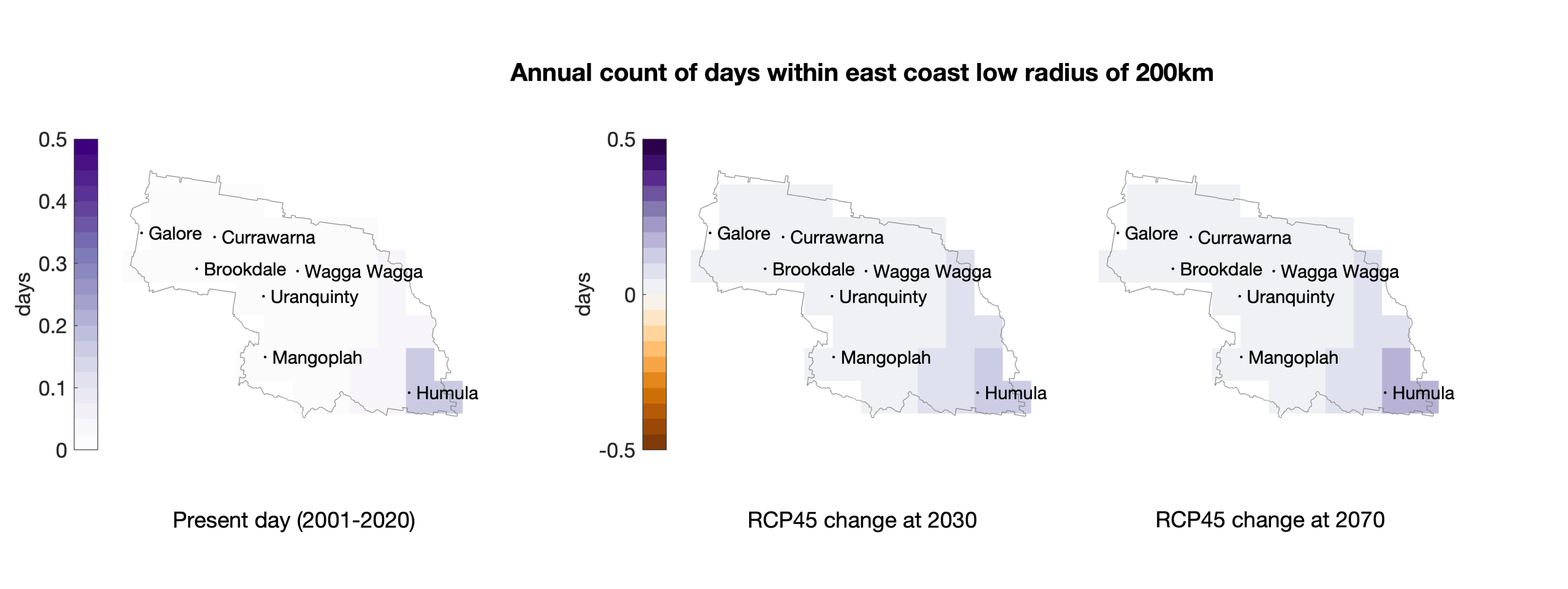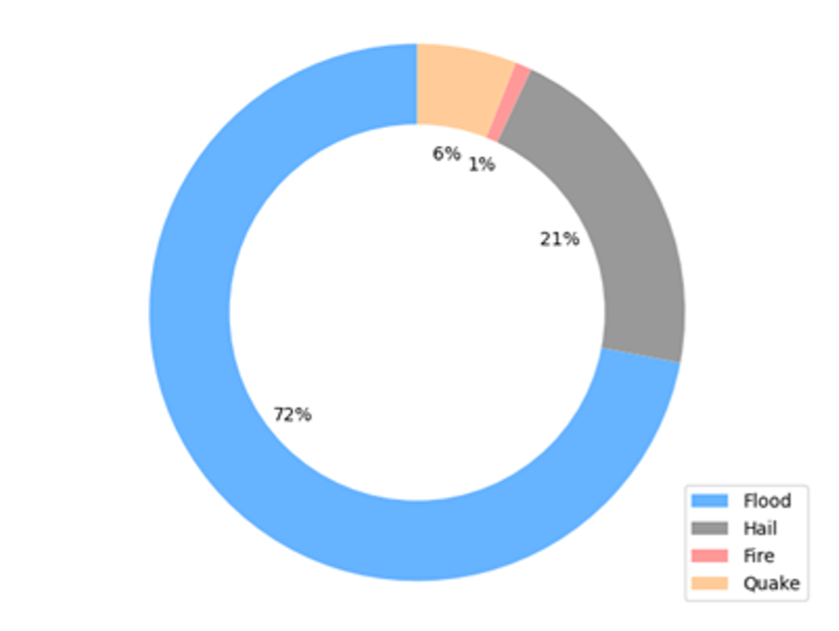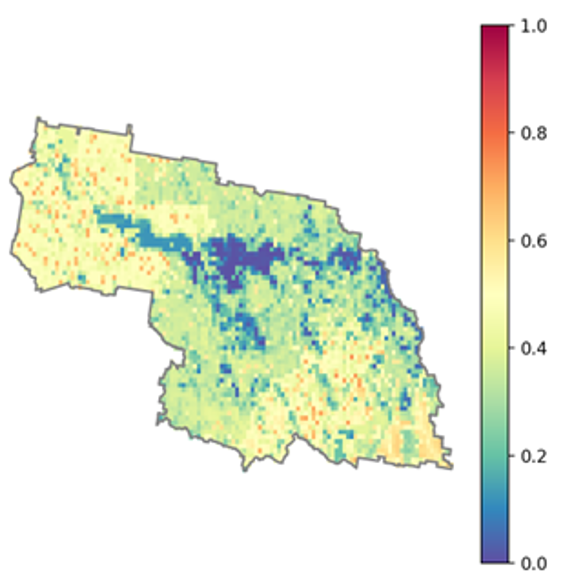Home » Your Local Area » Wagga Wagga
Local Profile for Wagga Wagga City Council
Wagga Wagga Local Government Area
Hazard Exposure Summary
Climate Change Data Summary
Risk Exposure Summary
Reference
Wagga Waga City Council is a local government area (LGA) located in the Riverina region of southern new South Wales (NSW). The LGA covers an area of 4,825km2 with an elevation of 214m above sea level.1
Wagga Wagga LGA is the traditional homelands of the Wiradjuri/Wiradyuri people, the biggest aboriginal tribe in New South Wales, and the original inhabitants of Wagga Wagga.
Wagga Wagga is situated approximately 450km south-west of Sydney and 460km north of Melbourne. The City is bounded by Coolamon and Junee Shires in the north, Gundagai and Tumut Shires in the east, Tumbarumba, Greater Hume and Lockhart Shires in the south, and Narrandera Shire to the west2.
Socio-Demographic Profile
In 2024, the estimated residential population for Wagga Wagga was 68,951 persons. ³
In 2021, based on the Australian Bureau of Statistics (ABS) 2021 census date, Wagga Wagga consisted of:
- Population – 67,609; ⁴
- Aboriginal and Torres Strait Islander population – 4,466; ⁵
- Number of property/dwellings – 28,250; ⁶
- Persons aged under 5 – 6.8% (4,578 persons); ⁷
- Persons aged over 65 – 16.6% (11,196 persons); ⁸
- Persons with disability – 5.9% (3,998 persons); ⁹
- Number of new residents – 1,342 persons (since 2021);
- Persons culturally and linguistically diverse (CALD) / non-English speaking at home – 9.1% (6,165 persons; and 10
- Top 5 languages (other than English) spoken at home – Kurdish, Malayalam, Mandarin, Filipini/Tagalog and Arabic. 11
Based on recently revised population projects from the NSW Department of Planning, the population of the Council area is expected to grow to 75,767 people by 2041 (+6,823 by natural change and +852 by migration). A link to further information outlining growth trends in Upper Lachlan, including graphs can be found here: https://www.planning.nsw.gov.au/data-and-insights/population-projections/explore-the-data#-local-government-area-projections- .
Economic Profile
Wagga Wagga LGA has one of the most diverse economies in the country.12
Public Administration and Safety in Wagga Wagga was valued at $678 million in 2022/2023, with Defence contributing to $489.8 million.13 Health Care and Social Assistance was similarly valued at $634.2 million, with Social Assistance Services contributing to $217.4 million.14
The top three industries employing local workers in the Wagga Wagga LGA in 2022/2023 were:15
- Health Care and Social Assistance (19.0%);
- Construction (11.2%); and
- Education and Training (10.6%).
Mining has the highest productivity in 2022/2023, generating $371,682 per worker.16
Wagga Wagga LGA generated $5.41 billion of Gross Regional Product (GRP) in the year ending June 2023, growing 4.0% since the previous year.17
Environmental Profile
Wagga Wagga has a varied topography ranging from flat floodplains near Murrumbidgee River and creek systems to moderately steep hills in the east forming the foothill to the Great Dividing Range. Areas which are not forming part of the floodplain are largely gently undulating in nature18.
Outside of the urban areas, vegetation is across the LGA is predominately cleared pasture and cropping with pockets of natural vegetation. Between the Hume Highway and the eastern boundary of the LGA are limited areas of commercial forestry operations19.
The main land use is Primary Production which encompasses 90.78% of the LGA. This is followed by Rural Landscape (1.9%), Forestry (1.86%) and Infrastructure (1.8%).
cropping and grazing, which is followed by residential and farm infrastructure and native forestry production.
Governance Profile
The has a population which primarily reside in the city of Wagga Wagga, followed by Kooringal and Lake Albert20. The City’s name derives from the language of the Wiradjuri people, the biggest aboriginal tribe in New South Wales, and the original inhabitants of Wagga Wagga.
The city has a thriving business, sports and arts communities that is rich in cultural heritage and traversed by the Hume Highway (the busiest interstate freight corridor in Australia), Olympic Highway, Stuart Highway and the Melbourne-Sydney railway line. The main industry for employment in the City is health care and social assistance. This is followed by public administration, retail trade, construction, and education and training21.
As of 2021, agricultural productivity in Wagga Wagga was valued at $333 million with broadacre cropping (wheat, canola and barely) accounting for approximately $210 million (63%) of the total agricultural productivity. This was followed by livestock slaughter, mostly cattle and sheep, at 27%.
The Council has 7 elected Councillors. The Mayor and Deputy Mayor are elected by the community and are recognised as the civic leaders of the community. 22
Hazard Exposure Summary
The LGA is vulnerable to a wide range of natural hazards, making it essential to understand the nature and extent of exposure to people, buildings, infrastructure, services, or natural resources to effectively assess and address associated risks.
Exposure can be seen in various forms:
- Relative exposure is a function of hazard, describing the frequency and magnitude of natural hazard events and capturing the compounding effect of multiple hazards (fire and flood for this analysis). Where a community is subject to both fire and flood, it is potentially less resilient than one exposed to a single hazard of the same frequency and magnitude;
- The physical exposure of a community is determined such that the quantum of exposed people, buildings, essential facilities, industry, and agriculture can be evaluated. The physical vulnerability of exposed elements is also important, such as the age and construction type of buildings (for example, buildings with raised floors are more resilient to flood as they provide greater protection to the occupants and their belongings, resulting in less loss of life and property); and
- Social vulnerability is determined by examining socio-economic and demographic factors that may exacerbate or ameliorate the effects of an external threat to a person’s life, livelihood, or assets. Examples of these types of indicators include age, occupation, health status, income and education.
The Resilience Blueprint identified the following hazards as relevant hazardous events for the southeast NSW region. In 2024 the State Disaster Mitigation Plan (SDMP) was implemented and any additional hazards or information regarding exposure of hazard in the region has been included below:
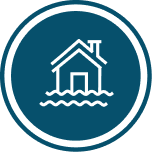 Flooding
Flooding
- Wagga Wagga has a history of flood events with 77 floods recorded since the early 1840s.23
- There have been years of frequent floods, i.e. in one year 1974 Wagga Wagga had five floods all over 8.92 m and there was severe flooding in the 1950 to 1956 period.24
- 2022 and 2012 flooding events forces residents to evacuate Wagga Wagga with flood waters reaching above 8 metres
- Based on potential event probability, annual average loss of residential, commercial and industrial buildings due to flooding is estimated at 72 per cent. This accounts for high probability and high-cost consequence of earthquake activity.
- Overland flow flood behaviour typically occurs as when the capacity, of the local drainage and the smaller creek systems flowing into the Murrumbidgee, is exceeded.25
- 1962 properties impacted by flooding over floor and 12,934 properties impacted externally across the Study Area. The annual average damages for residential and commercial/industrial properties was found to be $16.09M. This represents the average cost of flooding each year.26
- In historic flood events, entire homes have been inundated by flood waters, and in others the flood waters will reach 1.5m through the homes. Many people assume each flood will be like the last, however, this is not usually the case. 27
Actions taken:
- Council consulted with WMA Water to develop the Wagga Wagga Major Overland Flow Floodplain Risk Management Study and Plan which provides a suite of recommendations for mitigation and adaptation.
- Council has undertaken 6 flood management studies in collaboration with external consultants. These include:
- Uranquinty Levee feasibility and Design
- Glenfield Drain Flood Mitigation Options
- Lake Albert Flood Mitigation Options
- North Wagga Flood Mitigation Options
- Humula and Mangoplah Flood Studies
- Levee Pump Augmentation Scheme
- Council has also undertaken floodplain risk management studies and plans for the villages of Tarcutta, Landysmith and Uranquinty.
- Council is committed to ongoing monitoring and review of flooding through flood risk management planning for both riverine and overland flow flooding.28
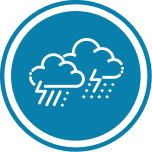 Severe storm
Severe storm
- Severe thunderstorms are the most common and most damaging types of storms in NSW. These storms have a short life span and only affect areas a few kilometres across. Although severe thunderstorms can occur at any time, there is a marked tendency for thunderstorms and severe thunderstorms to occur during months from October through to March. 29
- In January 2025, Wagga Wagga was struck with a severe storm that left several people injured, treed uprooted and fallen over and a wide-scale power outage.30
- The January 2025 thunderstorm brought heavy rainfall and strong winds that resulted in the bringing down trees and tree limbs, which damaged buildings, vehicles and some infrastructure in suburban and rural areas across the Wagga Wagga LGA. It was noted as the “one of the biggest clean-up efforts we’ve had to organise in years in terms of the amount of trees and branches brought down and how widespread the damage was in our LGA”. 31
- Based on potential event probability, annual average loss of residential, commercial and industrial buildings due to hail is estimated at 21 per cent. This accounts for low probability but high cost consequence of earthquake activity.
Actions taken:
- NSW Government released an extended disaster recovery support grant.
- In 2018, the NSW Government released a NSW State Storm Plan, a Sub Plan of the State Emergency Management Plan (EMPLAN)
- Council consulted with WMA Water to develop the Wagga Wagga Major Overland Flow Floodplain Risk Management Study and Plan which provides a few of recommendations for mitigation and adaptation to storm events.
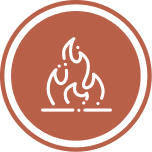 Bushfire and grassfire
Bushfire and grassfire
- The frequency of dangerous bushfire weather days and the magnitude of bushfire weather extremes will increase particularly in Wagga Wagga which is already experiencing such days.
- The largest changes for bushfire weather across southeast Australia are expected to be occurring during the spring, with a projected earlier onset of the bushfire season under a warmer climate.
- In September of 2024, the Wagga Wagga LGA was urged to prepare for the upcoming bushfire season due to warmer weather conditions and prolific vegetation growth after consecutive wet years increasing the fire risk. 32
Actions taken:
- Council is committed to reviewing and updating bushfire hazard mapping with the Rural Fire Service to ensure our planning reflects the most up to date risks associated with bushfire events. Future development must respond and plan to minimise bushfire risks to property and people.33
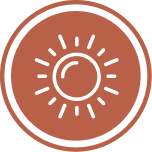 Heatwave
Heatwave
- The magnitude of temperature extremes and frequency of hot days will increase for inland LGAs, particularly for Wagga Wagga.
- Largest increases in heatwave and high temperature extremes will be seen during the summer months.
- High temperature extremes will also occur more frequently during spring and autumn.
- In November of 2024, major power stations left the LGA without power amidst a heatwave, with temperatures reaching up to 39 degrees Celsius. 34
- In December of 2024, a heatwave stretched through the Wagga Wagga LGA and temperature rose up to 15 degrees Celsius above the annual average. The maximum temperature reached was 42 degrees Celsius. 35
Actions taken:
- Council have developed a Heatwave Response Plan Checklist.
Climate Change Data Summary

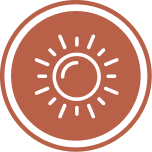
Heatwave – measured by number of days with temperatures greater than 35°C
Heatwaves are a critical climate hazard affecting health, infrastructure, and ecosystems. Heatwave risk can be measured by tracking the number of days per year with maximum temperatures exceeding 35°C. This analysis, undertaken by Risk Frontiers in 2021, drew on 20-year averages from historical climate reanalysis data and future climate model projections under a ‘medium’ emissions scenario, represented by RCP4.5 (see below).
The data highlights how the frequency and seasonality of high-temperature events are expected to shift over time in the LGA, informing the need for climate adaptation in infrastructure, health, and planning decisions.
Figure 1 – Frequency of days per year with temperature greater than 35 Celsius Degrees
(Values are 20-year averages for present day climate and change for future under the RCP4.5 scenario)
Key findings:
- The magnitude of temperature extremes and frequency of hot days will increase for inland LGAs, particularly for Wagga Wagga
- Largest increases in heatwave and high temperature extremes will be seen during the summer months
- High temperature extremes will also occur more frequently during spring and autumn.
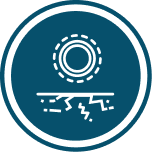
Drought – measured by Leetch-Byram Drought Index, soil moisture and annual precipitation
Drought is a complex hazard influenced by temperature, rainfall, and how water is retained in the landscape. To assess how drought conditions are projected to change in the LGA, this analysis undertaken by Risk Frontiers in 2021 uses three key climate indicators:
- Keetch-Byram Drought Index (KBDI) – a widely used index that estimates how dry the landscape is based on temperature and rainfall. It also reflects the flammability of surface fuels and is commonly used for fire management (see Figure 2 below);
- Soil moisture percentiles – a direct measure of how much water is retained in the soil compared to long-term conditions. Soil moisture is essential for agriculture, vegetation health, and ecosystem resilience (see Figure 3 below);
- Total annual precipitation – tracks overall rainfall trends, which are a key input for drought but must be considered alongside evaporation and temperature to understand drought risk fully (see see Figure 4 below).
Figure 2 – Annual mean Keetch-Byram Drought Index (KBDI) drought index value normalised on a scale of 0-10, where 10 is the maximum drought possible
(Values are 20-year averages for present day climate and change for future climate under the RCP4.5 scenario)
Figure 3 – Annual mean soil moisture percentiles; values are calculated relative to present day climate, hence the 50% values for present day. Low values at 2070 are indicative of a drying landscape
(Values are 20-year averages for present day climate and change for future climate under the RCP4.5 scenario)
Figure 4 – Total annual precipitation in mm per year
(Values are 20-year averages for present day climate and change for future climate under the RCP4.5 scenario)
These indicators are derived from climate model simulations using 20-year averages for present-day and future scenarios under RCP4.5. Together, they provide a fuller picture of both short-term and long-term drought potential, capturing the interplay between rainfall, heat, and water retention in the landscape.
Key findings:
- inland LGAs are more exposed and susceptible to drought, particularly for Wagga Wagga
- Under future climate, by 2070 the magnitude of drought will increase across all LGAs, especially those already most affected which includes Wagga Wagga
- By 2070 the magnitude of drought will increase across the Council area as soil moisture declines by 2070, with the greatest impact occurring during the winter and spring
- Changes in total annual rainfall are less than the projected changes in soil moisture and drought, suggesting that the increase in drought is being driven primarily by increasing temperatures and their effect on evapotranspiration.

Bush and grassfire – measured by the annual maximum Forest Fire Danger Index (FFDI)
Bushfires and grassfires are among the most dangerous and disruptive climate-related hazards in South-East NSW Region. The annual maximum Forest Fire Danger Index (FFDI) is the nationally recognised measure for assessing bushfire danger and is widely used by emergency services to guide fire warnings, restrictions, and preparedness. FFDI is a composite index that incorporates temperature, wind speed, humidity, and recent rainfall to estimate how dangerous fire weather is on a given day.
This analysis undertaken by Risk Frontiers in 2021 used 20-year averages from historical reanalysis data and future climate projections under the RCP4.5 scenario (see Figure 5 below). This indicator helps identify trends in both the severity and seasonal timing of fire weather across the LGA.
Figure 5 – Magnitude of bushfire weather severity as represented by the annual maximum FFDI
(Values are 20-year averages for present day climate and change for future climate under the RCP4.5 scenario)
Key findings:
- The frequency of dangerous bushfire weather days and the magnitude of bushfire weather extremes will increase particularly in Wagga Wagga which is already experiencing such days
- The largest changes for bushfire weather across southeast Australia are expected to be occurring during the spring, with a projected earlier onset of the bushfire season under a warmer climate.
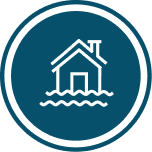
Extreme rainfall and flooding – measured by daily precipitation over 30mm
Flooding poses a significant hazard to infrastructure, communities, and emergency services. This analysis uses the frequency of very heavy rainfall days (daily rainfall greater than 30mm) as an indicator of flood risk. This threshold (i.e., days with more than 30mm of rain often) is a recognised benchmark in climate and hydrological studies to identify rainfall events that can overwhelm stormwater systems, trigger flash flooding, and lead to significant overland flow.
Projections done by Risk Frontiers in 2021 compared 20-year averages for present day conditions with those for 2030 and 2070 under the RCP4.5 scenario (see Figure 6 below). This helps to understand how the intensity of rainfall events changes, which is crucial for flood management, infrastructure design, and emergency planning.
Figure 6 – Frequency of very heavy rainfall days (>30mm)
(Values are 20-year averages for present day climate and change for future climate under the RCP4.5 scenario)
Key findings:
- The primary driver of year-to-year variability in rainfall will continue to be the tropical climate drivers of Indian Ocean Dipole (IOD), El Niño Southern Oscillation (ENSO) and the Inter-decadal Pacific Oscillation (IPO). Projections for Pacific climate are indicating an increase in ENSO amplitude, meaning both El Niño and La Niña events will be stronger
- Extreme rainfall events will produce higher rainfall totals due to the physical relationship between a warmer temperatures and higher atmospheric moisture capacity
- Higher rainfall totals may lead to higher flood levels during flooding events, but the frequency of these events will not differ significantly from present.

Severe storm, wind and hail – measured by East Coast Low (ECL) days and annual windspeed
Severe storms, ranging from East Coast Lows to thunderstorms and hail events, pose a recurring hazard to communities and infrastructure. This analysis uses two key indicators to evaluate storm-related risk under a changing climate:
- Frequency of East Coast Low (ECL) days – ECLs are among the most damaging storm systems affecting the region, often associated with extreme winds, heavy rainfall, large waves, and coastal erosion. Tracking their frequency is important for understanding long-term storm risks; and
- Annual maximum windspeed – is used to assess the strength of storm systems and frontal weather events that can bring down trees, damage infrastructure, and increase fire danger.
These indicators help assess changes in both the occurrence and severity of damaging weather systems.
Figure 7 – Frequency of east coast low days
(Values are 20-year averages for present day climate and change for future climate under the RCP4.5 scenario)
Figure 8 – Annual maximum windspeed (km/hr).
(Values are averaged across each LGA and calculated as 20-year averages for present day climate and change for future climate under the RCP4.5 scenario—windspeeds at individual locations and years will be significantly higher than the averages.)
Projections done by Risk Frontiers in 2021 were based on 20-year averages comparing present-day conditions with future scenarios for 2050 and 2070 under RCP4.5. This helps identify trends in the intensity and potential impacts of storm systems in the LGA which may influence risk planning, emergency management, and infrastructure resilience.
Key findings:
- Under present day climate, the Council area is exposed to several types of storms, including east coast lows (ECL), extra-tropical lows, fronts, snowstorms, thunderstorms, and hailstorms
- ECL are one of the most damaging storm types to impact the Council area. ECL frequency is expected to increase slightly under future climate which is consistent with an expectation of increased large scale interactions between warm and cool air masses as the climate warms
- Storms tend to be more frequent during La Niña events and less frequent during El Niño events. This relationship is not expected to change under a warming climate
- Extratropical lows and associated fronts and thunderstorms can cause significant risk, especially during summertime when they are a primary cause of dangerous bushfire weather
- Maximum annual windspeed is projected to increase across the Council area, suggesting an increase in the strength of frontal systems.
NARCLiM 2.0 findings for the Upper Lachlan region
In 2022 NARCliM 2.0 climate data was publicly released – this is the most up-to-date regional climate modelling available for NSW and ACT and is used Government planning, assessments, and strategies.
Table 2 below describes the anticipated future climate projections specific to the Upper Lachlan LGA based on NARCLiM 2.0 SSP1-2.6 (low emissions) and SSP3-7.0 (high emissions) scenarios.
This information can also be viewed through an interactive climate change projection map via https://www.climatechange.environment.nsw.gov.au/projections-map
Table 2 – NARCLiM 2.0 Emissions Scenario projections – Wagga Wagga
Risk Exposure Summary
A hazard is a natural process or occurrence, a source event which has the potential to result in harm or cause loss or damage depending on exposure. Risk exposure is the degree to which people, places, or assets are at risk from hazards.
The South Eastern Regional Emergency Management Plan has identified the following hazards as having risk of causing loss of life, property, utilities, services and/or the community’s ability to function within its normal capacity:
|
|
|
In 2024, the NSW State Disaster Mitigation Plan identifies these additional 3 hazards having the same risk to life and property: 37
- Coastal hazard (erosion and inundation)
- Storms and cyclones, and
- Tsunami.
The climate modelling performed by Risk Frontiers in 2021 as part of the Resilience Blueprint found that Wagga Wagga has:
- moderate/medium flood hazard risk with 19.08% of the land within a modelled floodplain. This is primarily follows the Murrumbidgee River and its tributaries stemming from west to east (Figure 9)
- moderate bush and grassfire hazard risk with a modelled annual burning probability of 1.93%. This risk area is largely concentrated in vegetated areas such as Murraguldrie and Livingstone National Park (Figure 10).
Figure 9 – Wagga Wagga Flood Hazard Index
A dark blue indicates a flood plain, the lighter colour out of it.
The flood hazard index uses a map of modelled flood plains identified by several geographical/geospatial variables including different river types, river stream order, distance to river network, land cover, soil type, average slopes in known flood areas, relative changes in elevation near rivers, and river basin characteristics.
Figure 10 – Wagga Wagga Flood Hazard Index
Life, Property, Economic and Environmental Loss Risk
Fatalities and life loss
Figure 11 – Wagga Wagga fatalities from natural hazard
As shown in Figure 11 above, the risk that is posed to life is very difficult but a reality to of natural hazards. From a human health perspective, life loss throughout the region from 1900 to 30 June 2020 has been analysed using PerilAUS, Risk Frontiers’ database of natural hazard impacts.
The analysis found that in Wagga Wagga, floods has resulted in the most fatalities – 7 fatalities, followed by bushfire (2 fatalities), heatwave (1 fatality), and lightning (1 fatality).
Despite the above, more lives have been lost as a result of the impacts of disaster events across the City in the days, weeks, months and years that follow. The physical and mental health toll of events is enormous.
Health issues and fatalities are not captured – data in these regards is difficult to bring together but does not change the reality of the pervasive impact of disasters.
Impact on Property and Infrastructure
Figure 12 – Distribution of the Average Annual Loss (AAL) of infrastructure by hazard for Wagga Wagga
In terms of the risks posed to property and infrastructure, Risk Frontiers’ Natural Catastrophe loss models have been used to estimate the financial cost, or Average Annual Loss (AAL) across four key hazards in the City being bushfire, flood, hailstorm and earthquake. The models evaluated losses for commercial, residential and industrial properties.
Under current conditions, the overall baseline AAL for Wagga Wagga is approximately $15 million.
The analysis found that riverine flood is the most significant natural hazard accounting for 72% of the AAL, followed by hail (21%) and earthquake (6%) as shown in Figure 12.
Future climate projections indicate that the AAL in Wagga Wagga will be driven by fire and flood losses. Losses are projected to increase slightly by 19% for fire and 3% for flood by 2070 under a RCP 4.5 scenario with a total AAL of $15.5 million.
Average Annual Loss identified in the State Disaster Mitigation Plan
The SDMP indicates that the AAL in the Wagga Wagga LGA for built environment in 2023 consisted of the following:
- Coastal hazard (erosion and inundation) – Very Low;
- Storms – Low – Moderate;
- Cyclones – Very Low; and
- Tsunami – not recorded but noted as a rare event.
Editors note: the SDMP does not include specific AAL per LGA. It is colour coded on a scale from $0m to $112m.
Environmental Loss Risk
Risks to threatened flora, fauna and ecological communities from fire and flood were analysed using the following values:
· threatened ecological communities · land use · land cover | · protected areas · connectivity · maximum above-ground biomass | · fauna, flora and ecological communities · weed, pest and animal disease. |
The fire and flood indices were overlaid with an exposure index locating threatened flora, fauna and ecosystems along with agricultural lands. The analysis found that there are:
- Fauna exposure is medium. There are 19 different vulnerable animal species in the region, of which 11 are vulnerable, 4 are endangered, and 4 are critically endangered.
- Flora exposure is low/moderate. There are 6 different vulnerable plant species in the region, of which 4 are vulnerable, 4 are endangered and 2 are critically endangered.
- Ecological community exposure is low/moderate. There are 3 different vulnerable ecological communities in the region, of which 1 are endangered and 2 are critically endangered.
- The analysis also that the natural environment encompasses 4% of the region (1.3% of which is protected), 68.21% devoted to agriculture and farming and the remaining 23.39% is developed built environment.
The total maximum above ground biomass (indicating the potential vegetation density the LGA could support) is low with 1,687 tonnes of dry matter over the LGA.
Overall, Wagga Wagga’s environment has moderate/medium exposure as seen in Figure 13.
Figure13-Wagga Wagga overall exposure index
Agricultural Productivity
While there are no significant changes for rainfall, worsening drought conditions associated with warming temperatures will directly lead to lower overall soil moisture as seen in Table 1 A projected decrease in soil moisture from a warmer climate may impact beef and cropping productivity under a warmer climate in Wagga Wagga.
There is a correlation between agricultural productivity and climate parameters representing temperature and hydroclimate variability. Productivity of beef and sheep operations tends to be higher during years that are wetter and cooler with retained soil moisture, and low risk of consecutive dry days. This correlation is particularly significant for sheep, but not as significant for beef however, there are there are sensitivities to hot days and drought conditions as shown in Figure 14 below.
Vulnerability and Capacity
Resilience is generally regarded as a function of the intersection of relative exposure, social vulnerability and community capacity:
- Relative exposure is a function of hazard, describing the frequency and magnitude of natural hazard events and capturing the compounding effect of multiple hazards (fire and flood for this analysis).
- Physical exposure of a community is determined such that the quantum of exposed people, buildings, essential facilities, industry, and agriculture can be evaluated.
- Social vulnerability is determined by examining socio-economic and demographic factors that may exacerbate or ameliorate the effects of an external threat to a person’s life, livelihood, or assets.
- Community capacity to resist, avoid and / or adapt to a disaster and to use these abilities to create security either before or after a disaster can be determined by examining several factors.
For each of these measurement framework indicators, an index has been produced by a weighted average of each metric contributing to the category. An analysis of the measurement framework indicators for each Statistical Area 1 (SA1) across South East NSW culminates as an integrated index of resilience; Figure 15 and Figure 16 shows community resilience indices for Wagga Wagga.
- In Wagga Wagga, the mean relative exposure component of the resilience index is high for bush/grass fire and average for flood. 31% of the population resides in SA1s scoring low or worse for resilience to flood and 2.2% in SA1s scoring low or worse for resilience to bush/grass fire.
- 7% of the population resides in SA1s scoring low or worse for resilience to flood and 3% in SA1s scoring low or worse for resilience to bush/grass fire.
- The Council area’s mean social vulnerability score is low average. 31% of the population reside in SA1s scoring low or worse for the social vulnerability component of resilience.
- The mean community capacity component of the resilience index is high average for bush/grass fire, and average for flood. 4.6% of the population score low or worse for the community capacity component of resilience to flood and 0.9% score low or worse for the community capacity component of resilience to bush/grass fire.
Gaps in Data
While this local profile is underpinned by robust regional data and hazard modelling, several key data gaps remain that limit the precision of localised risk reduction planning:
- Community preparedness and capacity indicators: No recent community survey data exists on disaster readiness, access to emergency plans, or levels of volunteering in disaster response organisations.
- Historical event records: Detailed local records on the frequency, impacts, and recovery costs of past snow, storm, hail, and earthquake events are limited or not centralised.
- Economic disruption data: There is insufficient insight into how previous disasters have impacted the local economy, particularly small businesses, tourism, and agricultural supply chains.
- Infrastructure interdependencies: Modelling on critical infrastructure interdependencies (e.g., how flood risk to roads affects emergency access or supply deliveries) is not available at the LGA level.
- Monitoring and evaluation systems: Council currently lacks a framework to consistently track resilience outcomes over time, including climate impact monitoring and post-disaster recovery effectiveness.
- Integration of hazard overlays into planning instruments: While hazard data exists (e.g., fire and flood overlays), there is limited evidence that these are fully embedded within the Local Environmental Plan (LEP) or Development Control Plan (DCP), limiting the effectiveness of risk-informed development controls.
Reference
- NSW Department of Primary Industries and Regional Development, 2025, Wagga Wagga: Our climate. Available online at https://www.dpi.nsw.gov.au/about-us/science-and-research_old/centres/wagga/our-climate
- Wagga Wagga EMPLAN 2015
- .idcommunity, 2024, Welcome to Wagga Wagga City Council Community Profile. Available online at https://profile.id.com.au/wagga-wagga/
- .idcommunity, 2021, Wagga Wagga City Population and dwellings. Available online at https://profile.id.com.au/wagga-wagga/population
- .idcommunity, 2021, Wagga Wagga City Key statistics. Available online at https://profile.id.com.au/wagga-wagga/first-nations-keystatistics
- .idcommunity, 2021, Wagga Wagga City Population and dwellings. Available online at https://profile.id.com.au/wagga-wagga/population
- .idcommunity, 2021, Wagga Wagga City Five year age groups. Available online at https://profile.id.com.au/wagga-wagga/five-year-age-groups
- Ibid
- .idcommunity, 2021, Wagga Wagga City Need for assistance. Available online at https://profile.id.com.au/wagga-wagga/assistance
- .idcommunity, 2021, Wagga Wagga City Language used at home. Available online at https://profile.id.com.au/wagga-wagga/language
- Ibid
- City of Wagga Wagga, 2025, Economic Development Study. Available online at https://wagga.nsw.gov.au/business-investment/investing-in-wagga/studies-and-surveys
- .idcommunity, 2023, Wagga Wagga City Value added. Available online at https://economy.id.com.au/wagga-wagga/value-add-by-industry
- Ibid
- .idcommunity, 2023, Wagga Wagga City Employment by industry (Total). Available online at https://economy.id.com.au/wagga-wagga/employment-by-industry
- .idcommuntiy, 2023, Wagga Wagga City Worker productivity. Available online at https://economy.id.com.au/wagga-wagga/worker-productivity-by-industry
- .idcommunity, 2023, Wagga Wagga City Gross Regional Product. Available online at https://economy.id.com.au/wagga-wagga/gross-regional-product
- Wagga Wagga EMPLAN 2015
- Wagga Wagga EMPLAN 2015
- .idcommunity 2022
- .idcommunity 2022
- City of Wagga Wagga, 2025, Councillors. Available online at https://wagga.nsw.gov.au/the-council/about-council/councillors
- City of Wagga Wagga, 2021, Local Strategic Planning Statement. Available online at https://wagga.nsw.gov.au/the-council/planning-and-reporting/community-planning/current-community-plans/lsps
- Ibid
- WMA Water, 2021 WAGGA WAGGA MAJOR OVERLAND FLOW FLOODPLAIN RISK MANAGEMENT STUDY AND PLAN. Available online at https://wagga.nsw.gov.au/imagesfiles/documents/services/flood-management-studies/2021-wagga-wagga-major-overland-flow-floodplain-risk-management-study-and-plan/MOFFRMS_FINAL_WEB.pdf
- Ibid
- State Emergency Service, 2025, Local Flood Insights: Murrumbidgee River. Available online at https://storymaps.arcgis.com/stories/50dbc33dddcb444b9e3c526342cfc32d
- City of Wagga Wagga, 2021, Local Strategic Planning Statement. Available online at https://wagga.nsw.gov.au/the-council/planning-and-reporting/community-planning/current-community-plans/lsps
- NSW Reconstruction Authority, 2024, State Disaster Mitigation Plan. Available online at https://www.nsw.gov.au/sites/default/files/noindex/2024-02/State_Disaster_Mitigation_Plan_Full_Version_0.pdf
- Region Riverina, 2025. Four injured, trees down and power out after wild weather whips through Wagga. Available online at https://regionriverina.com.au/four-injured-trees-down-and-power-out-after-wild-weather-whips-through-wagga/80703/
- City of Wagga Wagga Council News, 2025, Council’s storm clean-up efforts clearing our nature strips. Available online at https://news.wagga.nsw.gov.au/news-articles/2025/january/storm-clean-up-efforts-clearing-our-nature-strips
- New South Wales Government, 2024, Communities in Wagga Wagga urged to Get Ready for fire scenario. Available online at https://www.nsw.gov.au/media-releases/get-ready-for-fire-season
- City of Wagga Wagga, 2021, Local Strategic Planning Statement. Available online at https://wagga.nsw.gov.au/the-council/planning-and-reporting/community-planning/current-community-plans/lsps
- News.com.au, 2024, Major power stations ‘unavailable’ as heatwave worsens in NSW. Available online at https://www.news.com.au/technology/environment/power-outages-threaten-millions-as-heatwave-grips-parts-of-australia/news-story/98f69c08e7bd4fb73b286e5185c14dea
- ABC News, 2024, Hottest summer weather in five years predicted for coming days as heatwave engulfs half of Australia. Available online at https://www.abc.net.au/news/2024-12-14/heatwave-half-australia-hottest-summer-weather-in-five-years/104723462
- South Eastern Regional Emergency Management Committee, 2021, South Eastern Emergency Management Plan’ (updated October 2023). Available online at https://www.nsw.gov.au/sites/default/files/noindex/2023-10/South_East_Region_EMPLAN_v2.1.pdf
- NSW Reconstruction Authority, 2024, State Disaster Mitigation Plan 2024-2026. Available online https://www.nsw.gov.au/sites/default/files/noindex/2024-02/State_Disaster_Mitigation_Plan_Full_Version_0.pdf


